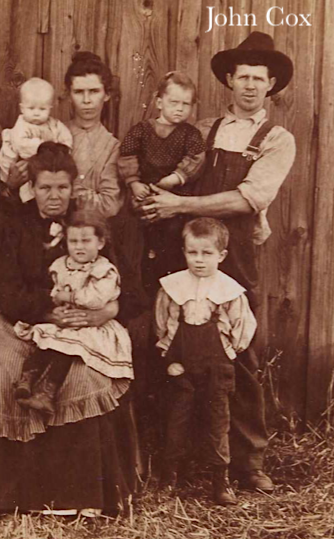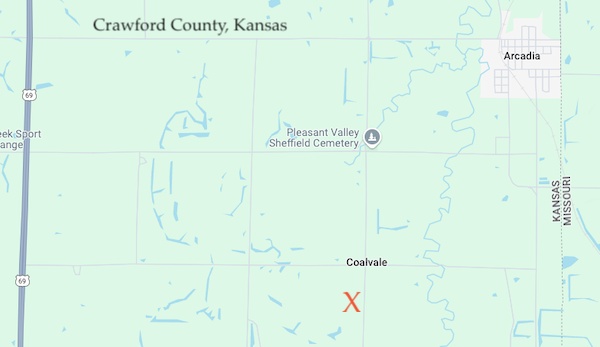
Pictured left to right: Top row - Bertha Cox holding Arthur Cox,
John Cox holding Violet Cox
Front row - Elva Ann Jenkins holding Mabel Leota, Floyd Cox

History's Hidden Gems
More News Articles
by Holly Swigart
John Cox Coal Miner
by Holly Swigart January 12, 2022
John Cox was eleven years old when he reported for his first day of work at the coal mine in 1897. And for the next twenty five years he never missed a single day. He was one of many hard working coal miners in Southeast Kansas willing to risk the dangers that came with the job in order to build a better life. Accidents were practically an everyday occurrence in the coal mines. Cave-ins, landslides, bad air, falling, fire, coal dust and explosions were just a few of the ways a man could get hurt or killed working in the mines.
When John Cox was twenty-two and already a ten year veteran of the mines, he narrowly escaped death from an explosion at the Englevale mine northwest of Arma, Kansas. The Englevale mine was especially prone to the danger of explosions because gas seeped into the tunnels from deep underground. John was assigned the task of "Brushing the gas away." He would go down into the tunnels early every morning without a lantern and work in total darkness trying to disperse the gas that had accumulated. He couldn't use a lantern because it would ignite the gas. Coal miners in those days used carbide lanterns which mixed calcium carbide with water to produce acetylene gas. They were useful because they produced a very bright light that illuminated a wide area. Early automobiles also used carbide lamps for headlights. Coal miners called this lantern a "Naked light," and the open flame of the lantern made it far too dangerous to take into an underground mine if there was gas present. The gas had to be cleared out before the other miners could go to work each morning.
On Sept. 28, 1908, John Cox was down in the dark tunnel working to brush the gas away when he looked up and saw a light at the entrance. He tried to yell at the unsuspecting miner to get away from the tunnel with that naked light, but it was too late. The explosion shook the town of Englevale, and Frank Mack, the man with the lantern was killed. But somehow miraculously, John Cox survived. Although he had burns on his hands and face, that didn't stop him from returning to work the very next day. He had a wife and children to support, after all.
By 1921, John's family had grown. He and his wife, Bertha lived on a small farm near Coalvale, Kansas, in Crawford County with their four children. Life was not easy, but they worked hard to make the best life they could for their family. Then came the big coal miners' strike of 1921. Even though John Cox had never before missed a day of work, he chose to stand with the more than 8,000 striking miners. The very right of the coal miners to go on strike hung in the balance. The miners were standing together in order to challenge a new Kansas law which denied coal miners the right to strike. The local mine workers were in a difficult situation. They were struggling to feed their families, and they had no coal to heat their homes. The national union had abandoned the miners of Southeast Kansas, ordering them to go back to work, but the men remained loyal to their local union leader, Alexander Howat. Howat was a coal miner himself, and the workers respected him. He was also a fiery speaker who inspired the men to stay true to the cause. Howat, along with several other local union leaders had spent weeks in the Crawford County jail in Girard for defying the law and ordering the strike. The whole community pulled together and helped each other. Thousands of women gathered in Franklin, Kansas, and marched to various mines in the area in support of their striking husbands, fathers and sons. Their tenacity was amazing. The strike lasted for months and when winter came, it was brutal.
On January 7, 1922, John Cox set out with two other miners, Clyde Moore and Clyde Collins on what would become a tragic day. Only one of them would make it back home. Out back of the Cox's farm was an abandoned mine where they hoped to find enough coal simply to heat their own homes. The January wind blew cold as the men arrived at the pit where a vein of coal was exposed. The three of them were hard at work when they were caught by surprise as the big wall above them suddenly collapsed. Clyde Moore was buried deep in the rubble and died instantly. John Cox was only partially buried, but the friends and neighbors who came running could not dig him out fast enough to save him. All of their tools had been lost in the landslide. It was a sad day for the small community of Coalvale. Only Clyde Collins survived. And ironically, the strike ended just five days later. Ultimately, the local coal miners won their fight with the industrial court and regained their legal right to strike.
During the early 1900s people flocked to Southeast Kansas to find jobs in the coal mines. They came here from many different countries. Some spoke Italian, German, Slovenian and a variety of other languages. What they all had in common, however, was a dream and a strong determination to create a good life. John Cox was not rich or famous or even well known. He had no great accomplishments other than the example he set. Not too long before the tragic landslide, there was a small mention in the local newspaper recognizing him for his perfect work record. As we remember him now, a hundred years later, it is with a sense of gratitude for John Cox and all those like him who worked hard, took care of their families, and stood up for what was right, even in the most difficult times.
Photo courtesy of the Jenkins/Cox family collection
